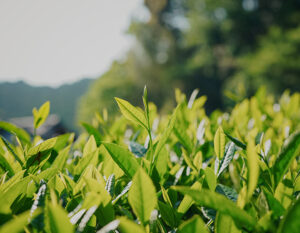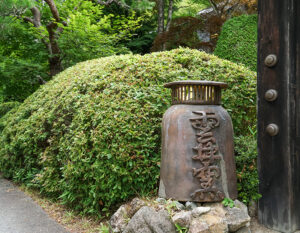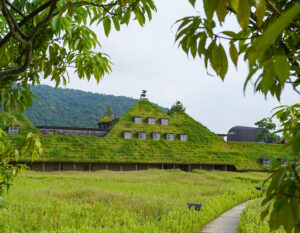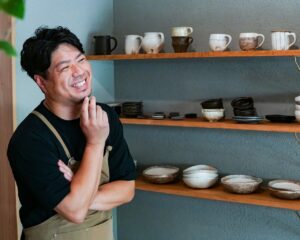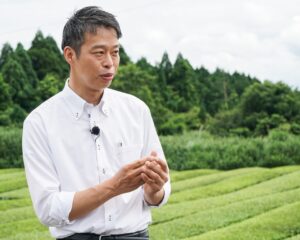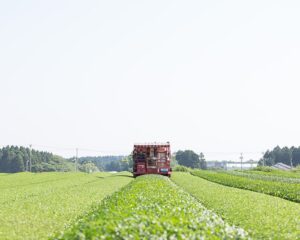Masadokoro is located in the mountains of the Suzuka Mountains on the east side of Lake Biwa. This small village with thatched roofs and clear water flowing from the verdant mountains has been producing “Masadokoro tea” since the Muromachi period (1333-1573). The tea is grown without the use of any pesticides or chemical fertilizers, and because of its rarity, it has been called “phantom tea.
Uji is a traditional tea production center, and tea is a traditional political center.
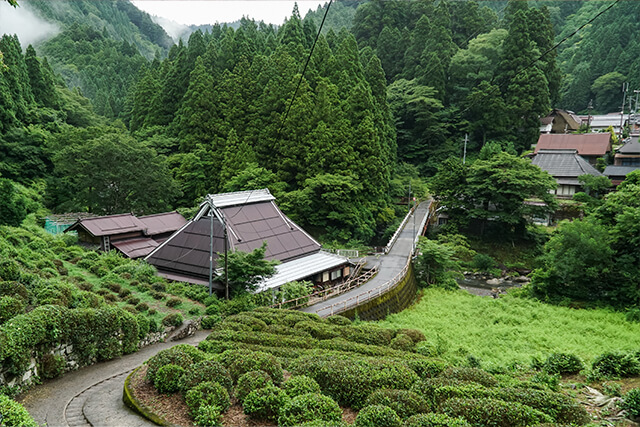
Masadokoro tea is said to have originated in the Muromachi period (1336-1573), when villagers were encouraged to cultivate tea for medicinal purposes in anticipation of the medicinal effects of the clear water of the Aichi River, which originates in the Suzuka Mountains on the border with Mie Prefecture, and the fog that forms in the valley. During the Onin War, when people evacuated from the capital of Kyoto to this area, the monks of Eigenji served tea grown in the temple, which became popular for its delicious taste. This led to the tea of Masasho being widely consumed in Kyoto, and the cultivation of tea leaves, which had been practiced only at temples, was introduced to the private sector, making Masasho a tea-producing area.
It is said that this Masasho tea was served to the young Mitsunari Ishida during the “Sankencha” episode, which led to his being taken in as a vassal by Hideyoshi Toyotomi.
A rare native species that has survived the harsh environment
Masasho tea is cultivated on a mountain slope at an altitude of 350 to 450 meters above sea level. The cultivation limit for tea is said to be 600 meters above sea level, so this is not a particularly high altitude, but the land is characterized by snowfall of more than 2 meters in winter. In addition, because of the short daylight hours in the mountains, the tea trees are covered with more than one meter of snow for about four months of the year. The harsh environment makes it difficult for varieties brought in from elsewhere to take root, and while the majority of tea trees grown throughout Japan are of the “Yabukita” variety, native varieties that have been handed down since the Muromachi period account for 70% of all tea trees in Masadokoro.
Fascinated by the original landscape of Japan, the land attracts young power.
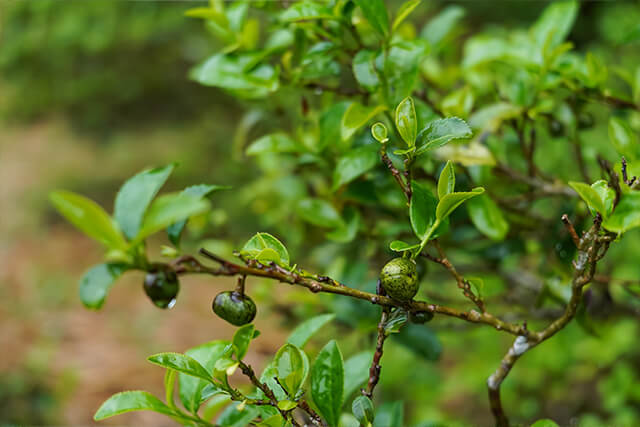
Tea cultivation was once so important to the people of Masadokoro that it was said that “tea and forestry alone were enough to make a living. However, with the rapid economic growth after World War II, tea production declined as more and more people went out to work. The area of tea fields was reduced to one-thirtieth of its peak, and Masadokoro tea, which was no longer marketable, came to be known as “phantom tea.
Currently, there are about 60 Masasho tea growers. However, the scale of production is small, and most of them grow only enough for their own consumption and ship the surplus as a commodity. The lack of commercialization has allowed tea production to continue in a more natural way, leaving behind a unique landscape where tea fields blend into the daily lives of the people. Attracted by such an original Japanese landscape, young power is now beginning to gather in Masasho.
I found myself offering to do it myself.
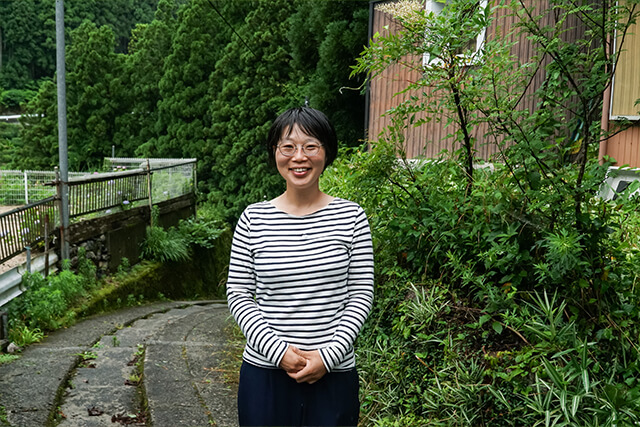
When I first came here, I saw the old men talking about Masadokoro tea, and it was so cool. I wanted to do something to help, and that’s how it all started,” said Ren Yamagata, the representative of “Cha En Musubi.
Ms. Yamagata first encountered Masasho 10 years ago. While attending disaster-stricken areas as a disaster volunteer following the Great East Japan Earthquake, he began to think that he wanted to live in a place with strong community ties. It was around this time that he was invited to visit Masadokoro by his former teacher from his college days. When Mr. Yamagata met a local man of nearly 80 years old for the first time, he told him, “The tea here is entrusted to us by our ancestors. I want to take good care of it, but I don’t want my children to have to go through the same hardships we did. I want to take good care of it, but I don’t want my children to have to go through the same hardships that we did. That was my wish, but I want to preserve this tea somehow, ” she said earnestly. She was so moved by his words that she decided to move to the area , saying, “If I have to throw it away anyway, please let me do it! and decided to move to the area. While promoting the appeal of Masasho tea to the outside world through Cha Enmusubi, Yamagata also serves as the director of the Masasho Tea Production Promotion Association and is working to establish a production and sales system for the tea industry.
Tea plantation he inherited while working as a doctor
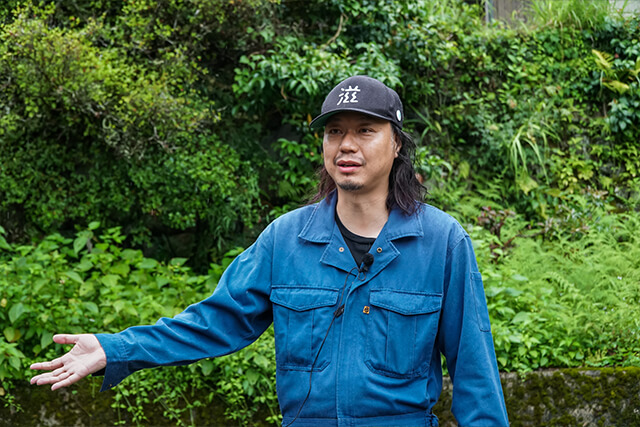
Another tea farmer who started growing tea after meeting Mr. Yamagata is Shigetaka Sato. He is a radiologist, which is surprising.
I was surprised to learn that he is a radiologist. ” Tea is a very familiar drink, but when I thought about it, I suddenly realized that I knew nothing about it. I wanted to learn more about it, so I was looking for a place in the prefecture where I could visit the production site, and that’s when I met Mr. Yamagata. The first time I was allowed to help pick tea, I enjoyed it more than I expected. After half a year of helping out every chance I got, he suggested to me, “If you’re going to help out so much, why don’t you start your own farm? I started growing my own tea.
Now, while attending the Masaki-cho in between work, he is enthusiastically working on tea cultivation with the help of the people around him. Under the name “Shige-Lu tea garden,” he grows tea leaves and promotes Masasho tea through workshops.
Tea trees over 300 years old

Tea plantations are usually thought of as neat rows of tea trees trimmed in the shape of a mantis, but Masasho’s tea plantation is a little different. The tea trees are scattered on the mountain slope and are generally short.
All the trees in this area are native species that are more than 100 years old,” he said. In the Masasho area, fields planted exclusively with native varieties are still scattered about as they were in the past,” says Yamagata.
The tree that spreads its branches as if crawling on the ground is over 300 years old, and is the oldest tree in the village. Of course, it is still in use today, and is designated as a natural monument by Shiga Prefecture. The tea trees in Masasho do not grow upward because of the heavy snowfall in winter, which causes the branches to bend under the weight of the snow. In spring, when the snow melts, a flattened tree emerges from the bottom and rises up from there,” Sato continues. The traditional native tea trees have disappeared since the end of World War II, due to the mechanization and diversification of the tea industry, and now only a few percent of them remain in Japan.
No pesticides are the norm.
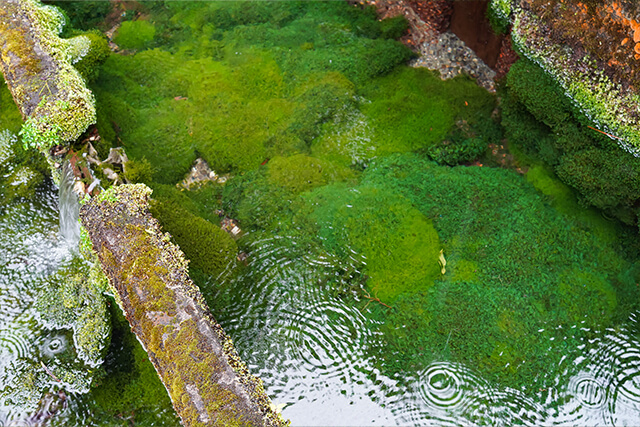
Walking around the village, one comes across clean spring water here and there. In Masadokoro, such spring water is still used for daily life.
The village of Masadokoro is located at the headwaters of the Aichi River, which flows into Lake Biwa. The people of Masadokoro believe that it is wrong to pollute the water if we, who live in the headwaters of the river, pollute the water, and it is natural that they do not use agricultural chemicals or chemical fertilizers. They do not even use insect repellant spray in their tea fields to prevent any chemical residue in the tea. The people here consider the standard of “good tea” to be the taste of the tea itself, and by extension, the taste of the local climate. Tea production has continued here since long before the advent of pesticides. I want to carry on the tradition of Masasho tea using the same production methods as in the past,” says Mr. Yamagata, revealing the pride of a production center that has been in existence for hundreds of years.
Hirabancha, a new Masasho staple
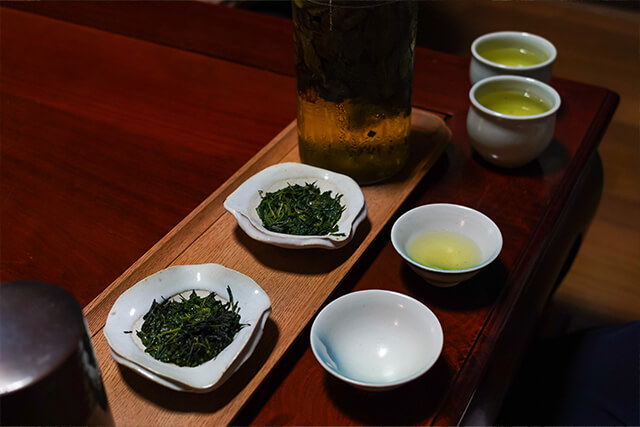
In Masadokoro, tea leaves that have matured and become hard are harvested by the branch at the end of March to make Bancha. The tea leaves are packed into a large wooden bucket, steamed, and dried after the branches are removed.
Before Mr. Yamagata came to Masasho, there was a lack of manpower, and the tea leaves were often left untouched after they were cut down to make Bancha, but now the Masasho Tea Production Promotion Association systematically harvests them. Until recently, people used to say, “Bancha is a tea for daily use. However, since its commercialization as hira-bancha, the number of fans has increased, and now the image of “Masasho as hira-bancha” is gaining ground. Its low caffeine content and sweet, gentle flavor make it easy to pair with any meal, which is probably another reason for its popularity. Some sommeliers drink it between glasses of red wine because it washes away tannins.
The packaging was devised to make it accessible to the younger generation, and tea bags were also created for easy drinking. As a result, new sales channels have been acquired, such as being placed in cafes and beauty salons, and the number of people who know about Masasho tea is steadily increasing.
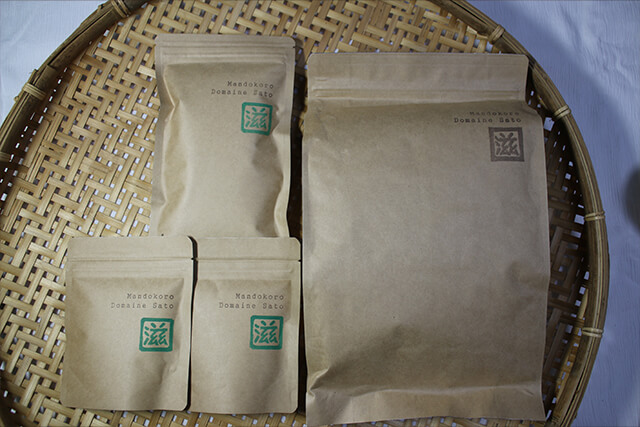
I don’t want to destroy a scene that has continued for hundreds of years.
It is still not easy to make a living only from the tea business. Still, I don’t want to see something of value that has continued for hundreds of years to be lost. There is a charm to this land that I don’t want to see lost,” says Mr. Yamagata. Seeing Mr. Yamagata and Mr. Sato happily continuing to make tea, more and more people are coming to the Masadokoro, saying, “I want to try it, too. These changes are also creating opportunities for young people who once left Masadokoro to return to the area.
While strengthening its foothold as a tea-producing region, Masadokoro will pass on its unique tea production to the future. The breakthrough of Masadokoro tea, which has made a new start, has only just begun.




